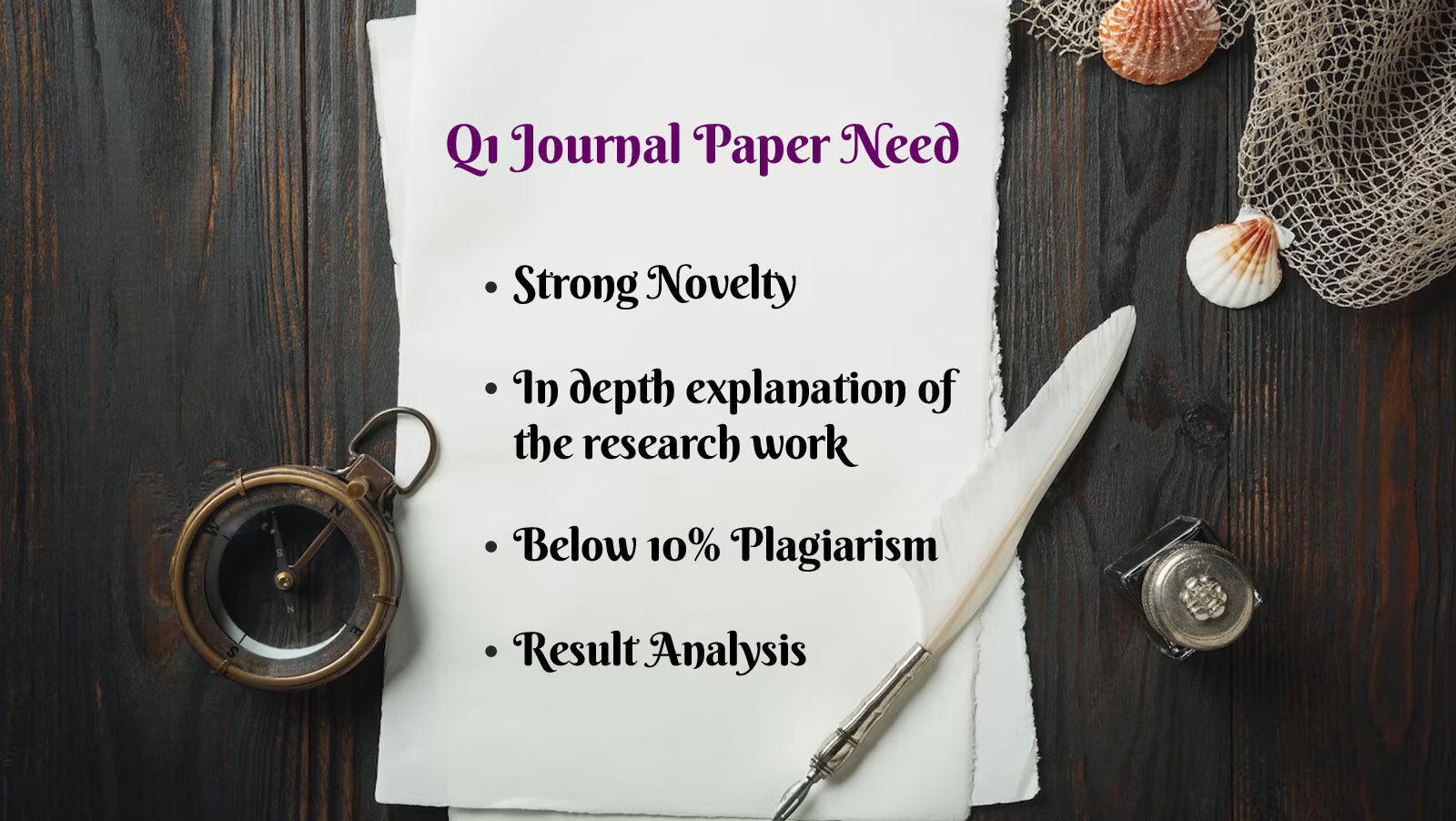At Zonduo, we specialize in Q1 journal publication support. From manuscript enhancement to formatting and submission, our team ensures your research meets the high standards of Scopus and Web of Science Q1 journals. Zonduo provides complete clarity on Q1 journal publication fees, whether you’re submitting to an open-access or subscription-based journal. We help you choose a reputable journal with fair processing charges and no predatory risks. If you're targeting a Q1 journal publication for your academic research, our experts guide you through journal selection, scope matching, plagiarism checks, and peer review preparation, increasing your chances of acceptance. We also assist researchers in exploring the latest Q1 Journal List to identify the best fit for their work. Understanding Q1 journal publication requirements is critical. We help you align your manuscript with technical, ethical, and formatting guidelines set by reputed Q1 journals, including impact factor considerations and citation benchmarks.
Q1 Journals denotes the top 25% of the Impact factor distribution. The Q1 journal is the most prestigious and highly cited publication. If a journal is ranked in the Q1 journal list, it means it is one of the best in the business. Journals have a rigorous peer review process and a low acceptance rate. Your journal should be original, novel, and robust research. Q1 journal follows the strict submission standard, such as author guidelines, formatting, and manuscript structuring.
Q2 denotes middle high Position (between 25%-50% of the Impact factor distribution). Q2 journal is considered high quality, not equal to a Q1 publication. Q2 journal receives good visibility and citations. Submission must present high quality, original research, and well prepared to increase the chance of acceptance. Q2 has a higher acceptance rate than Q1 publication.
Q3 denotes middle low position (between 50%-75% of the Impact factor distribution). Q3 journal is a less competitive process compared to Q1 and Q2 journals. Q3 has a wider acceptance chance compared to a top tier journal. It's perfectly suitable for an early career researcher.
Q4 denotes the lowest position (bottom 25% of the Impact factor distribution). Q4 journals have a broad acceptance chance. Compared to other journals (such as Q1, Q2, and Q3), Q4 has the lowest impact and academic visibility. It has a low rejection rate. Q4 journal publication takes a shorter time for review and submission. It's suitable for an early career researcher.

The Q1 Journal List 2025 serves as a standard for academic excellence. The Q1 journal list consists of journals that have demonstrated exceptional quality and impact in their respective fields. For researchers, having their work published in Q1 journals signifies recognition and validation of their contributions to the scholarly community.
Scholars wish to publish their academic papers in journals that are ranked in the Q1 journal list, as it demonstrates the quality and impact of their research and also enhances their academic reputation, boosting the chances of being cited in other research. Additionally, journals that are in the Q1 journal list have high advantages in increasing global visibility, advancement in their career. Publishing papers in a Q1 journal also opens doors for international collaborations and makes your research influential in shaping the future of researchers.
“Our desires are to understand your research aspires.”
Welcome to Zonduo Technology – Your No. 1 Guide to Q1 Journals. Are you a researcher or academic professional to publish your work in top-tier Q1 journals? Don’t look at any other assistants.. At Zonduo Technology, we provide valuable insights and some important resources to help you complete your academic studies without any obstacles.
Publishing in journals q1 offers numerous benefits for researchers, including:
There are many ways to find quartile of the each journal. Standardly we choose two websites there are,

Find the Q1 journals through Scimago contains the following steps,
To determine a journal's ranking in Scopus, follow these steps:
Note that Scopus denotes a journal's quartile based on percentiles. Specifically, percentiles 100 to 70 are considered Q1 Journals, which means they are in the Q1 journal list, 74 to 50 are considered Q2, and so on..
1. An impact factors measures the average score of citation gained by articles published in a journal over the past two years.
2. High impact factor (IF) values show the journal’s quality and influence.
| Fields | Journals Titles | Impact factor (IF) |
|---|---|---|
Medical |
1. Nature Medicine 2. The Lancet 3. British Medical Journal 4. Circulation 5. Nature Review Clinical Oncology |
~50 ~88.5 ~42.7 ~37.8 ~82.2 |
Engineering |
1. Nature Nanotechnology 2. Advanced Materials 3. Nano Energy 4. ACS Nano 5. Journal for Cleaner Production |
~34.9 ~27.4 ~17.1 ~16 ~10 |
Social Science |
1. Academy of Management Annals 2. Annual Review of Sociology 3. American Economic Review |
~16.5 ~9 ~11.9 |

Publishing in journals that are on the Q1 journal list can have significant benefits for an academic career. Here are some of the reasons why publishing in a Q1 journal is significant:
Researchers identifying a Q1 journal in a specific subject field based on citation metrics. Here are some following steps involve:

The Q1 journal publication fee in India varies based on journal type, publisher, and access model. While open-access journals often require an Article Processing Charge (APC) for Q1 journals, many subscription-based journals may not charge authors directly. However, additional costs can apply for elements such as color images, extra pages, or expedited review.
| Journal Type | Approximate Cost Range | Notes |
|---|---|---|
| Open Access (Gold) | Varies across publishers | Includes APC, usually for global access rights |
| Subscription-based | Often free for authors | Minimal costs; charges may apply in some cases |
| Hybrid Journals | Varies (optional open access) | Author chooses between free/subscription or paid OA |
Note: Zonduo does not charge any journal publication fees. We offer end-to-end Q1 journal publication support — from identifying the right Q1 journals to assisting with submission, peer review, and revisions. Along with identifying the Q1 journal list, our experts also help guide you on publisher fees, discounts, or waivers applicable to your institution or region.

The citation impact factor of a journal is used to determine its quartile ranking, including the Q1 journal list ranking. Here are the steps to calculate the citation impact factor for Q1 journals based on the provided search results:
Publishing a research paper in a Q1 journal can be an exciting experience. However, it is important to understand the publishing process to increase your chances of success. Take a quick look at the latest Q1 Journal List — it really helps to know where your work fits best. Here are some key steps to follow:

Publishing your academic papers in the Q1 journals has a strong impact and a high reputation in your academics. These journals are considered standard journals, so it has many advantages for scholars to publish their papers in Q1 journals. You can always check the Q1 Journal List first — it gives a clearer picture of where your paper truly belongs. Some key benefits of publishing in journals Q1 are:
Copyright is one of the major issue that every scholar face in the rejection of a paper. Before you even get started, it helps to glance through the Q1 Journal List — it gives you an idea of the journals’ policies and what they expect from authors. Here are some steps to be followed by researchers to avoid copyright issues while submitting a paper to a Q1 journal:

Copyright is one of the major issue that every scholars face in rejection of paper. Here are some steps to be followed by researchers, to avoid copyright issues while submitting paper in Q1 journal are:
To avoid copyright issue, the scholar should develop their own style and ensure that their work stands out with originality without any plagiarism. If the scholar has their own writing style, then there is less chance of copying the work of others. . Ensure that the entire manuscript is written by your own unique contribution and not copied from any existing article.
The scholar should paraphrase their writings correctly. When the scholars discuss existing literature, while paraphrasing, the scholar should express their idea in a new way using their own vocabulary and a new structure, without changing its original meaning. It also increases the chance of their work being published in Q1 journals.
Follow citation guidelines style such as APA, MLA, OR Chicago, for citations and references, including every source for ideas, data, figures, and text. It’s also smart to peek at the Q1 Journal List once in a while — it helps you stay on track with journal standards and expectations. Scholars should keep a record of their sources, which helps them ensure that they are using legal sources and helps to avoid copyright issues.
It is very important for every writer to maintain a good quality of notes about all the sources referred to, citations such as database articles, books, images, or personal communications. This practice enables you to follow any section of your paper back to its source, confirming that your work is accurately attributed. . This helps to avoid any copy right issues.
Scholars should write their papers from scratch to avoid plagiarism. Every researcher should ensure that their writings are original and properly cited. Standardized journals like Q1 journals use software like Turnitin plagiarism checker to detect plagiarism in your paper. Any copied text without a proper citation can lead to rejection.
To avoid copyrights issues, scholar should properly cite all content referred to in the writing process and researchers should also maintain records for all sources. If you fail to cite properly, it can lead to immediate rejection or later rejection after initial acceptance.
Before applying to Q1 journals, ensure that your research topic matches the journal's scope.
Use Web of Science or the SJR platform to verify that the journal is indexed in the Q1 journal list.
Carefully review the journal's guidelines and manuscript structure and formatting to avoid rejection.
Q1 journals are highly competitive, so it is essential to understand the journal's peer review process.
If English is not your first language, but the journal is published in English, consider our Zonduo team to improve the quality and clarity of your writing.
We focus on offering extensive thesis support to ensure your thesis meets the high academic standards. If you’re eyeing journals from the Q1 Journal List later, starting with a strong thesis really helps. Get your premium thesis writing help without high-pressure get rich. Our thesis writing charges are designed to suit student budgets. When you choose Zonduo for thesis writing help, you will get a trusted partner who can help you through every stage of your thesis. Many of our scholars even aim for Q1 journals after completing their thesis — and we guide them there too. From research to final proofreads, our thesis writing solutions offer the best thesis writing support you need to succeed. Contact us today to discuss your requirements, get an instant quote, and experience the difference in our expert thesis writing support.
If a journal is Scopus-indexed, it means that Scopus reviewed and approved the journal after checking the journal's quality, standard, and contribution. The journal gets higher credibility and global recognition when it is indexed in Q1 journals. Scholarly journals that are listed in Scopus, one of the largest and most reputable abstracting and citation databases run by Elsevier, are known as Scopus-indexed journals.
| S.No | Journal | Publisher |
|---|---|---|
| 1. | IEEE Transactions on Pattern Analysis and Machine Intelligence | IEEE |
| 2. | Engineering Structures | Elsevier |
| 3. | Journal of Structural Engineering | American Society of Civil Engineers |
| 4. | Biomaterials | Elsevier |
| 5. | Journal of Materials Science and Technology | Chinese Society of Metals |
| 6. | Acta Geotechnica | Springer Nature |
| 7. | Advanced Powder Materials | KeAi Communications Co. |
| 8. | Nature Materials | Springer Nature |
| 9. | Advanced Functional Materials | John Wiley & Sons |
| 10. | Materials Today | Elsevier |
| 11. | Artificial Intelligence | Elsevier |
| 12. | Machine Learning | Springer Nature |
| 13. | Neurocomputing | Elsevier |
| 14. | Advanced Powder Materials | KeAi Communications Co. |
| 15. | Nature Medicine | Springer Nature |
To verify that recommended journals are not predatory or low-quality, it depends on several established methods and resources, ensuring recommendations align with academic integrity and quality standards. Sometimes, cross-checking with the Q1 Journal List gives a quick idea if the journal is truly reputable. And honestly, looking for journals that are actually listed under Q1 journals can save you from a lot of future trouble.
Zonduo’s Q1 journal publication support includes every responsibility, such as manuscript editing, plagiarism check, and copyright compliance review, to ensure papers meet the high-impact journal. If you’re ever unsure where to start, just take a peek at the Q1 Journal List — it really helps narrow things down.

Publishing in a Q1 journal is a major milestone for academic researchers, PhD scholars, and professionals aiming to elevate their careers. Sometimes, just going through a Q1 Journal List gives you clarity on where your work truly fits. At Zonduo, we specialize in Q1 journal publication support to help you meet the highest academic standards and get published in globally recognized journals indexed in Scopus, Web of Science, and SCI. Getting into Q1 journals isn’t just about writing — it’s about strategy, timing, and the right guidance.
Academic research demands credibility, originality, and global visibility. Publishing in Q1 journals helps scholars:
Zonduo’s Q1 journal publication services are designed to align your academic research with the stringent quality expectations of top-tier journals.
We offer:
Zonduo proudly announces we have successfully delivered sustainable projects to many clients across many countries. Our experienced writers dedicatedly deliver successful academic papers, which got published in high standard journals.
Q1
Q2
Q3
Q4

Here are some of the Q1 journal list of 2025 are:
International Journal of Information Management
Telematics and Informatics
ENERGY
International Journal of Mechanical Sciences
Composite Structures
Engineering Applications of Artificial Intelligence
Materials and Manufacturing Processes
Journal of Hydrodynamics
Journal of Power Sources
Journal of Biomechanics
Building Simulation
Emerging Markets Finance and Trade
North American Journal of Economics
Artificial Intelligence
Knowledge and Information System
Decision Support Systems
Batteries and Supercaps
Information and Organization
Journal of Enterprise Information Management
Journal of Enterprise Information Management
Information Society
Big Data Research
Geotextiles and Geomembranes
Thin-Walled Structures
Vehicular Communications
How to Publish a Research Paper in q1 Journal 2024?
Every scholars wish to publish their research paper in standardize Q1 journal which has high impact in their academics. In this blog you’ll get to know how to publish your research paper in Q1 journals.
How to Prepare Q1 Paper
Every scholars wish to publish their academic papers in this reputable Q1 journals, but this Q1 journal has some important guidelines for the publication. To know more about it
Honest reviews from our clients. Happy clients, Happy us.







1. Do we offer Q1 journal publication for UK scholars?
Yes, Zonduo also offers the best Q1 journal publication service for UK scholars. They guide you to craft a well structured academic writings as per the standard and formatting style of UK and assist you throughout the process of publishing UK scholars paper in reputable Q1 journal.
2. What is the Q Index?
The Q index of a journal paper is a way to very much see the importance of your manuscript and it also exposes its significance. It looks at different important things like total times that the paper has been cited, the reputation of the journals and it exposes where it's actually cited, and how relevant the citing articles while comparing to the paper's topic.
3. Why Does the Q Index is very important?
The Q index gives us very important information about how much impact and attention of a research paper. Papers with a higher Q index are seen as more important and are often thought as really very important works in their fields.
4. How is the Q Index actually calculated?
The Q index is figured out by looking at different things,
like total times that the paper has been cited, the
reputation of the journals and it exposes where it's
actually cited. Some of the different databases and groups
might have slightly different ways of figuring out the Q
index.
By using the journals q1 index for paper evaluation, then
Researchers, universities, and groups that provide funding
for research thoroughly use the Q index to assess the impact
of individual papers, researchers, and research projects.
5. Do we offer Q1 journal publication for UK scholars?
Yes, Zonduo also offers the best Q1 journal publication service for UK scholars. They guide you to craft a well structured academic writings as per the standard and formatting style of UK and assist you throughout the process of publishing UK scholars paper in reputable Q1 journal.
6. How can I identify the right journal for my research manuscripts?
Our expert team evaluate your research and recommends suitable journals that match your research area, scope and indexing preference.
7. How do I initiate a service request?
You can get started by sharing your project details through our website form or email. We’ll receive your requirements and respond instantly.
8. What is the typical cost for publishing in a Q1 journal?
Cost vary depends on the journal and level of service required. We offer an affordable price quotation after reviewing your manuscript.
9. Will my project details remains confidential?
Yes, we assist with PhD coursework, assignment, and seminar presentation and academic projects related to your specific research area.
Identify the journal:
It's very important to determine the specific Q1 journals for which you want to check the Q1 impact index. You may already know the name of the journal or need to search for it based on your research interests.
Access academic databases:
You need to utilize academic databases such as Web of Science, Scopus, PubMed, or Google Scholar.
Search for the journal:
Always prefer to use the search function within the academic database to find the Q1 journals you're interested in. Just enter the full name of the journal or use keywords related to your research topic to narrow down the search results.
Review journal metrics:
Once you've located the journal, go to to its profile or homepage within the database. Just look for information related to journal metrics, including its quartile position (Q1, Q2, Q3, or Q4) and impact factor.
Verify quartile position:
Check if the journal is ranked in the Q1 journal list of its respective category or field. Being in the Q1 journal list indicates that the journal is among the top 25% of journals in terms of impact and influence within its discipline and relevant field.
Consult multiple sources:
It's mostly advisable that you need to consult with multiple academic databases and sources to verify the Q1 status of a journal that is listed in the Q1 journal list and ensure the accuracy and reliability of the information.
By following these steps and utilizing academic databases effectively, you can check the Q1 journal impact index, and you also need to make very important decisions about where to publish your research or access high-quality scholarly content as well.